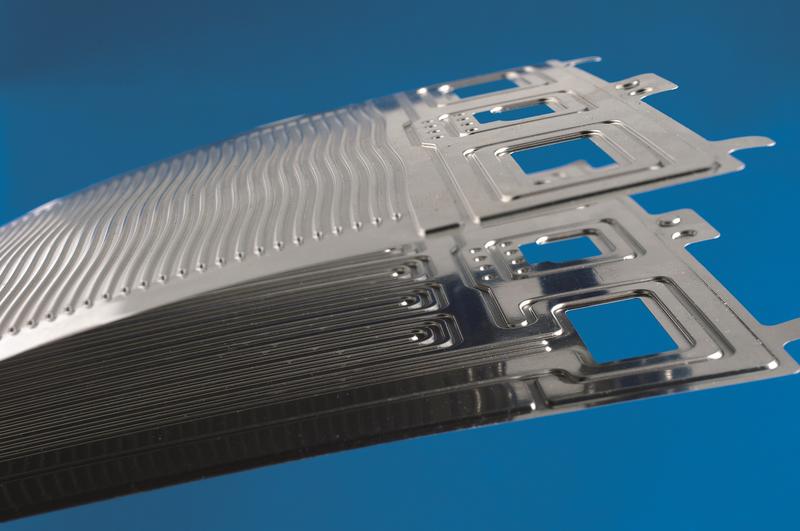

Fraunhofer ILT will be holding its Laser Colloquium Hydrogen LKH2 on March 18, 2020. It will focus on laser welding and cutting of bipolar plates and the entire fuel cell manufacturing process chain.
© Fraunhofer ILT, Aachen, Germany
On March 18, 2020, LKH2 attendees will be treated to a wide range of presentations covering the use of laser technology in the realm of hydrogen: the first element in the periodic table is a key element of fuel cells.
Some experts regard fuel cells as a smart alternative for addressing global mobility challenges due to their high energy efficiency.
The use of hydrogen in fuel cells is attracting increasing attention in numerous applications, especially since it is widely regarded as a useful addition to other activities in the world of e-mobility.
Growing interest among industry experts, researchers and policymakers
“We’re getting an increasing number of inquiries about fuel cells, hydrogen infrastructure and similar topics,” says André Häusler, team leader for the micro joining of metallic materials at Fraunhofer ILT.
“Policymakers are also paying more attention to this new technology, because when you take into account all the aspects of producing and recycling lithium-ion cells, you start to wonder how sustainable electric drives really are – especially considering the changes that must be made to the power grid.”
Toyota and Hyundai are two companies that have taken these concerns on board. They recently began offering fuel cell vehicles as an integral part of their product range, highlighting the benefits these offer over electric vehicles in terms of both range and ease of energy storage.
It also takes considerably less time to refuel a car with hydrogen than to charge an electric battery.
Highly efficient laser technology available along the entire process chain
Laser technology has a key role to play in fuel cell manufacturing, with highly efficient laser methods now available at every stage of the process chain. The Aachen-based experts are therefore confident that the use of laser technology will continue to expand in this area thanks to its outstanding flexibility and high degree of automation.
Bipolar plates: more work needed on process expertise
The colloquium aims to examine the current state of the art with presentations on topical issues such as the production of bipolar plates. Depending on the specific design in each case, a fuel cell typically consists of around 200 of these catalyst-coated plates, which serve as electrodes.
These require hydrogen-proof seals throughout, potentially leading to seam lengths of over 200 meters for each fuel cell.
Nevertheless, researchers at Fraunhofer ILT recently discovered, much to their surprise, that there are virtually no specialist publications of any major significance on the fabrication and production of bipolar plates.
They were also keenly aware that methods such as laser beam welding have traditionally been too slow to get the job done.
Easily weldable configurations optimize joining processes
This has inspired them to take a closer look at the process. “We aim to work with specialists from industry and research to find out what the key problems currently are,” says Häusler, explaining the motivation behind the project.
“We’ll be tackling issues such as easily weldable designs that facilitate laser joining and the complex laser cutting of prefabricated bipolar plates.”
Users employ both metal and polymer-based bipolar plates, so the colloquium will also include a presentation on laser joining of polymer plates. The Aachen-based team also has its sights set on the end-to-end process, with presentations scheduled to take place on establishing and monitoring process chains in a production setting.
Against this backdrop, funding approval was recently granted for a new project called CoBiP, which aims to create an innovative, turnkey solution for manufacturing high-quality bipolar plates. CoBiP covers all the key processes involved in micro rolling and forming, laser welding, laser cutting and coating.
The goal is to create an adaptable, autonomous solution that will significantly increase the efficiency and quality of the value chain. The project “CoBiP – Continuous roll-to-roll production of bipolar plates for fuel cells” will receive funding from the German Federal Ministry for Economic Affairs and Energy (BMWi) for a period of 3 years and is supervised by the Project Management Jülich (PtJ).
Participating in this project under the leadership of the Fraunhofer Institute for Production Technology IPT: Institute of Energy and Climate Research – Techno-Economic Systems Analysis (IEK-3) at Forschungszentrum Jülich, e.GO REX GmbH in Aachen, Precors GmbH in Jülich, Matthews International GmbH in Vreden and Fraunhofer ILT in Aachen.
Best practice from industry and research
Fraunhofer ILT is keen to provide a balanced mix of theory, research and practice and has already signed up a number of industry representatives to speak at the colloquium.
These include Gräbener Maschinentechnik from Netphen, a German pioneer in the production of bipolar plates, and plasmo Industrietechnik from Vienna, a company that specializes in a number of different fields, including quality assurance for automated laser welding processes.
The first Laser Colloquium Hydrogen LKH2 will take place at Fraunhofer ILT in Aachen on March 18, 2020. The presentations will be held in German. The registration deadline for the colloquium is February 19, 2020. Early birds who sign up on or before January 16, 2020 will receive a discount. Register online at www.ilt.fraunhofer.de/lkh2
André Häusler M. Sc.
Group Micro Joining
Telephone +49 241 8906-640
andre.haeusler@ilt.fraunhofer.de
Dr.-Ing. Alexander Olowinsky
Group Manager Micro Joining
Telephone +49 241 8906-849
alexander.olowinsky@ilt.fraunhofer.de
http://www.ilt.fraunhofer.de/en.html
http://www.ilt.fraunhofer.de/lkh2












